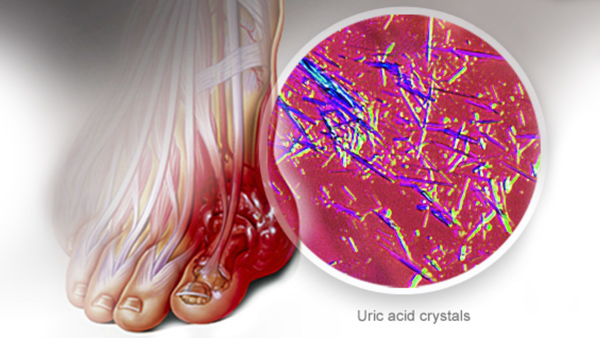What is gout?
Gout is a form of inflammatory arthritis that develops in some people who have high levels of uric acid in the blood. The acid can form needle-like crystals in a joint and cause sudden, severe episodes of pain, tenderness, redness, warmth and swelling.
What are the risk factors?
Genes: Risk of acquiring the disease increases if family members have gout.
Other health conditions: High cholesterol, high blood pressure, diabetes and heart disease may raise the risk.
Medications: Diuretic medications or “water pills” taken for high blood pressure can raise uric acid levels; so can some drugs that suppress the immune system taken by rheumatoid arthritis and psoriasis patients, as well as transplant recipients.
Gender and age: Gout is more common in men than women until around age 60.
Diet: Eating red meat and shellfish increases the risk.
Alcohol: For most people, more than two liquor drinks or two beers a day can increase the risk of gout.
Sodas: The fructose in sweet sodas has recently been shown to increase gout risk.
Obesity: Obese people are at a higher risk for gout, and they tend to develop it at a younger age than people of normal weight.
Bypass surgery: Those who have undergone gastric bypass surgery have an increased risk.
What are the symptoms of gout?
For many people, the first symptom of gout is excruciating pain and swelling in the big toe – often following a trauma, such as an illness or injury. Gout may also appear in another lower-body joint, such as the ankle or knee. Subsequent attacks may occur off and on in other joints, primarily those of the foot and knee, before becoming chronic.
Gout usually affects one joint at a time, but if left untreated it can affect many joints. Joint pain that used to resolve in a week to 10 days could become a milder, but constantone. Eventually, untreated gout can cause other problems. Tophi – painless but disfiguring lumps of crystals formed from uric acid may develop under the skin around joints. The crystals can also form kidney stones.
Gout is associated with other serious health risks such as high blood pressure, diabetes, chronic kidney disease and cardiovascular disease.
How is gout managed?
Treating gout requires a two-pronged approach that combines medications and lifestyle changes.
Treating an acute gout attack
Medications include nonsteroidal anti-inflammatory drugs (NSAIDs), corticosteroids and colchicine. NSAIDs are frequently used to quickly relieve the pain and swelling of an acute gout episode and can shorten the attack, especially if taken in the first 24 hours. Corticosteroids can be taken by mouth or injected into an inflamed joint to relieve the pain and swelling of an acute gout attack. They can also be injected systemically if the attack doesn’t respond to other medications or if many joints are affected. Colchicine is derived from a plant that has been used to treat gout for more than 2,000 years. It helps to relieve the pain and swelling of acute attacks.
Reducing uric acid levels
Medications that lower uric acid are intended to prevent gout attacks and keep the condition from becoming chronic. These include allopurinol, febuxostat, probenecid and pegloticase.
Your doctor will wait until your most recent gout attack is over before starting these medications, because taking them during an attack can worsen or prolong it. Taking these medications can be challenging – as uric acid levels drop, crystals in the joints may shift, triggering another attack. However, sticking with the treatment plan is the best way to prevent future attacks. Treating doctor may prescribe an anti-inflammatory medication such as a low, but regular dose of colchicine or an NSAID, along with one of the medications below for the first six weeks to 12 months to prevent attacks.
What lifestyle modifications are needed?
Adopting healthy lifestyle habits is a key part of an effective gout treatment plan. Eating a healthy diet, engaging in regular physical activity and losing weight if needed can lower the risk of repeated gout attacks, as well as the chances of developing heart disease, which is common in people with gout.
Diet
Developing a lifelong eating strategy that focuses on following a heart-healthy diet should be the goal for people with gout. This diet includes all the food groups, especially vegetables, whole grains, plant proteins such as nuts and legumes, and low-fat dairy. Refined carbohydrates and processed foods should be kept to a minimum.
The following foods are high in purines, or known to trigger gout attacks:
- Red meat and organ means (liver, tongue and sweetbreads)
- Shellfish such as shrimp and lobster
- Sugary beverages
- Excessive alcohol (more than one alcoholic drink for women and two for men within 24 hours)
Physical activity and weight management
Reaching and maintaining a proper weight is an important part of managing gout. Not only does losing weight help reduce the uric acid in the blood, it can lessen the risk of heart disease or stroke, both common in people who have gout. Being physically active is an important part of managing weight.
Reference: Arthritis Foundation. What is Gout? Retrieved from http://www.arthritis.org




